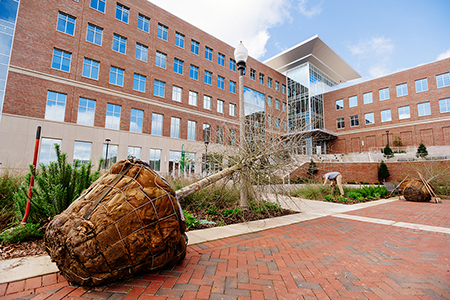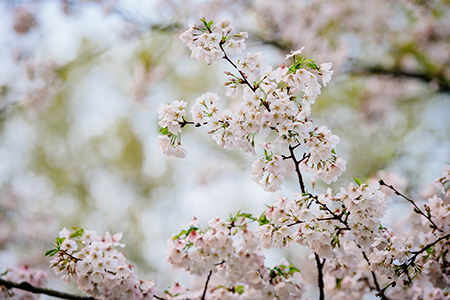Media contact: Yvonne Taunton
 For the sixth year, UAB is recognized by the National Arbor Day Foundation for its work to nurture more than 4,400 healthy trees and engage students and employees in conservation.As part of campus beautification near the University Hall area, which opened in fall 2019, willow trees recently were planted in the building’s front yard.
For the sixth year, UAB is recognized by the National Arbor Day Foundation for its work to nurture more than 4,400 healthy trees and engage students and employees in conservation.As part of campus beautification near the University Hall area, which opened in fall 2019, willow trees recently were planted in the building’s front yard.
For the sixth year, the University of Alabama at Birmingham is recognized by the National Arbor Day Foundation as a Tree Campus USA for its work to nurture more than 4,400 healthy trees and engage students and employees in conservation.
UAB also was honored for the first time with a Tree Campus Healthcare designation, which recognizes health institutions that make a mission-aligned impact on community wellness through tree education, investment and community engagement.
UAB is dedicated to preserving tree growth on campus, while accommodating campus construction. The UAB Facilities Division created a process to evaluate the trees and estimate their worth; if a tree or group of trees must be removed during construction, new trees equal to the value of those removed must be planted at the site or the equivalent dollar amount added to the Lynne and Tim Sullivan Tree Fund. Formerly known as the UAB Tree Fund, the account helps to maintain tree diversity, replace damaged or
| “Not only do trees give us cleaner air and scenic vistas — they remind us that we can grow and reach for the sky.” |
diseased trees, and add to the tree population on campus. It was renamed for recently retired UAB Facilities employee Tim Sullivan in March 2020.
“Tim cared about the trees at UAB and assembled a team to make this campus a designated Tree Campus USA by the Arbor Day Foundation back in 2014,” said Scott Moran, director of Facilities Support Services. “UAB has received that honor since.”
Within the past year, Moran says, money given to the fund has been used to have 40 of UAB’s live oak trees pruned, and special treatments have been given to several other campus trees to alleviate soil compaction and stop invading pests and fungi.
 The flowering Yoshino cherry tree, also known as the Japanese flowering cherry or cherry blossom, is one of UAB’s most beautiful features during spring. The campus is home to hundreds of these trees, many of them situated on the Campus Green.
The flowering Yoshino cherry tree, also known as the Japanese flowering cherry or cherry blossom, is one of UAB’s most beautiful features during spring. The campus is home to hundreds of these trees, many of them situated on the Campus Green.
Going green
Can you really put a dollar value on a tree? Yes, says Bambi Ingram, UAB Sustainability coordinator. There are costs you would have to bear if trees were not here to do the work for you. For example, throughout the course of 50 years, a single tree can generate $31,250 worth of air pollution control, recycle $38,000 worth of water and provide $31,500 worth of soil erosion-control. UAB’s trees have provided $125 million worth of air-pollution control and $126 million in soil-erosion control, and have recycled at least $152 million worth of water.
“Seeing UAB renew its commitment to tree health and sustainability year after year is encouraging,” Ingram said. “Not only do trees give us cleaner air and scenic vistas — they remind us that we can grow and reach for the sky.”
UAB was first designated a Tree Campus USA in 2015 for its accomplishments in 2014; the certification must be renewed annually.